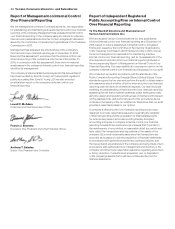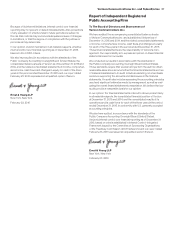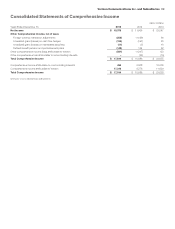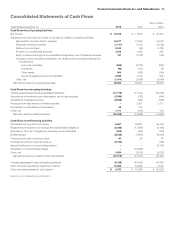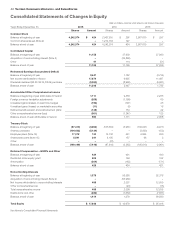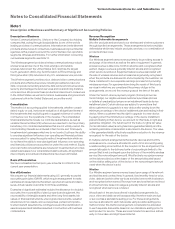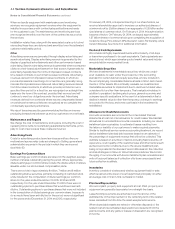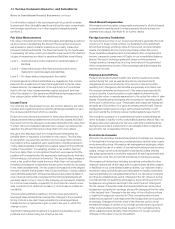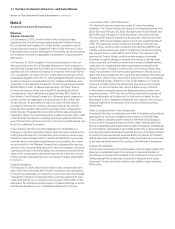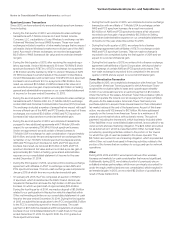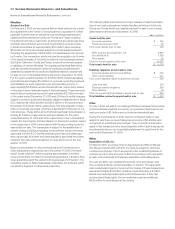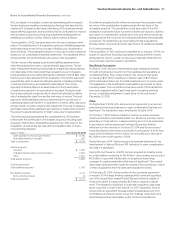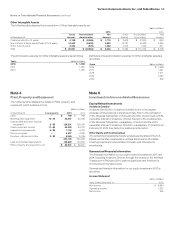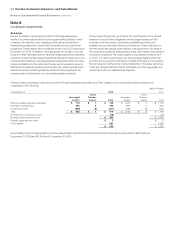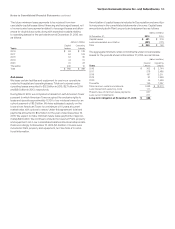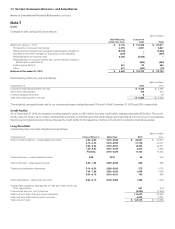America Online 2015 Annual Report Download - page 48
Download and view the complete annual report
Please find page 48 of the 2015 America Online annual report below. You can navigate through the pages in the report by either clicking on the pages listed below, or by using the keyword search tool below to find specific information within the annual report.For information related to the carrying amount of goodwill, wireless
licenses and other intangible assets, as well as the major components
and average useful lives of our other acquired intangible assets,
see Note3.
Fair Value Measurements
Fair value of financial and non- financial assets and liabilities is defined
as an exit price, representing the amount that would be received to
sell an asset or paid to transfer a liability in an orderly transaction
between market participants. The three-tier hierarchy for inputs used
in measuring fair value, which prioritizes the inputs used in the method-
ologies of measuring fair value for assets and liabilities, is as follows:
Level 1 — Quoted prices in active markets for identical assets or
liabilities
Level 2 — Observable inputs other than quoted prices in active
markets for identical assets and liabilities
Level 3 — No observable pricing inputs in the market
Financial assets and financial liabilities are classified in their entirety
based on the lowest level of input that is significant to the fair value
measurements. Our assessment of the significance of a particular
input to the fair value measurements requires judgment, and may
affect the valuation of the assets and liabilities being measured and
their categorization within the fair value hierarchy.
Income Taxes
Our effective tax rate is based on pre-tax income, statutory tax rates,
tax laws and regulations and tax planning strategies available to us in
the various jurisdictions in which we operate.
Deferred income taxes are provided for temporary differences in the
bases between financial statement and income tax assets and liabili-
ties. Deferred income taxes are recalculated annually at tax rates then
in effect. We record valuation allowances to reduce our deferred tax
assets to the amount that is more likely than not to be realized.
We use a two-step approach for recognizing and measuring tax
benefits taken or expected to be taken in a tax return. The first step
is recognition: we determine whether it is more likely than not that a
tax position will be sustained upon examination, including resolution
of any related appeals or litigation processes, based on the technical
merits of the position. In evaluating whether a tax position has met
the more- likely-than-not recognition threshold, we presume that the
position will be examined by the appropriate taxing authority that has
full knowledge of all relevant information. The second step is measure-
ment: a tax position that meets the more- likely-than-not recognition
threshold is measured to determine the amount of benefit to recognize
in the financial statements. The tax position is measured at the largest
amount of benefit that is greater than 50percent likely of being realized
upon ultimate settlement. Differences between tax positions taken in
a tax return and amounts recognized in the financial statements will
generally result in one or more of the following: an increase in a liability
for income taxes payable, a reduction of an income tax refund receiv-
able, a reduction in a deferred tax asset, or an increase in a deferred
tax liability.
The accounting standard relating to income taxes generated by
leveraged lease transactions requires that changes in the projected
timing of income tax cash flows generated by a leveraged lease
transaction be recognized as a gain or loss in the year in which the
change occurs.
Significant management judgment is required in evaluating our tax
positions and in determining our effective tax rate.
Stock-Based Compensation
We measure and recognize compensation expense for all stock-based
compensation awards made to employees and directors based on
estimated fair values. See Note10 for further details.
Foreign Currency Translation
The functional currency of our foreign operations is generally the local
currency. For these foreign entities, we translate income statement
amounts at average exchange rates for the period, and we translate
assets and liabilities at end-of- period exchange rates. We record
these translation adjustments in Accumulated other comprehensive
income, a separate component of Equity, in our consolidated balance
sheets. We report exchange gains and losses on intercompany
foreign currency transactions of a long-term nature in Accumulated
other comprehensive income. Other exchange gains and losses are
reported in income.
Employee Benefit Plans
Pension and postretirement health care and life insurance benefits
earned during the year as well as interest on projected benefit
obligations are accrued currently. Prior service costs and credits
resulting from changes in plan benefits are generally amortized over
the average remaining service period of the employees expected to
receive benefits. Expected return on plan assets is determined by
applying the return on assets assumption to the actual fair value of plan
assets. Actuarial gains and losses are recognized in operating results
in the year in which they occur. These gains and losses are measured
annually as of December 31 or upon a remeasurement event. Verizon
management employees no longer earn pension benefits or earn
service towards the company retiree medical subsidy (see Note11).
We recognize a pension or a postretirement plan’s funded status as
either an asset or liability on the consolidated balance sheets. Also, we
measure any unrecognized prior service costs and credits that arise
during the period as a component of Accumulated other comprehen-
sive income, net of applicable income tax.
Derivative Instruments
We enter into derivative transactions primarily to manage our exposure
to fluctuations in foreign currency exchange rates, interest rates, equity
and commodity prices. We employ risk management strategies, which
may include the use of a variety of derivatives including cross currency
swaps, foreign currency and prepaid forwards and collars, interest
rate swap agreements, commodity swap and forward agreements and
interest rate locks. We do not hold derivatives for trading purposes.
We measure all derivatives, including derivatives embedded in other
financial instruments, at fair value and recognize them as either assets
or liabilities on our consolidated balance sheets. Our derivative instru-
ments are valued primarily using models based on readily observable
market parameters for all substantial terms of our derivative contracts
and thus are classified as Level 2. Changes in the fair values of deriva-
tive instruments not qualifying as hedges or any ineffective portion of
hedges are recognized in earnings in the current period. Changes in
the fair values of derivative instruments used effectively as fair value
hedges are recognized in earnings, along with changes in the fair value
of the hedged item. Changes in the fair value of the effective portions
of cash flow hedges are reported in Other comprehensive income
(loss) and recognized in earnings when the hedged item is recognized
in earnings. Changes in the fair value of the effective portion of net
investment hedges of certain of our foreign operations are reported in
Other comprehensive income (loss) as part of the cumulative trans-
lation adjustment and partially offset the impact of foreign currency
changes on the value of our net investment.
46 Verizon Communications Inc. and Subsidiaries
Notes to Consolidated Financial Statements continued


